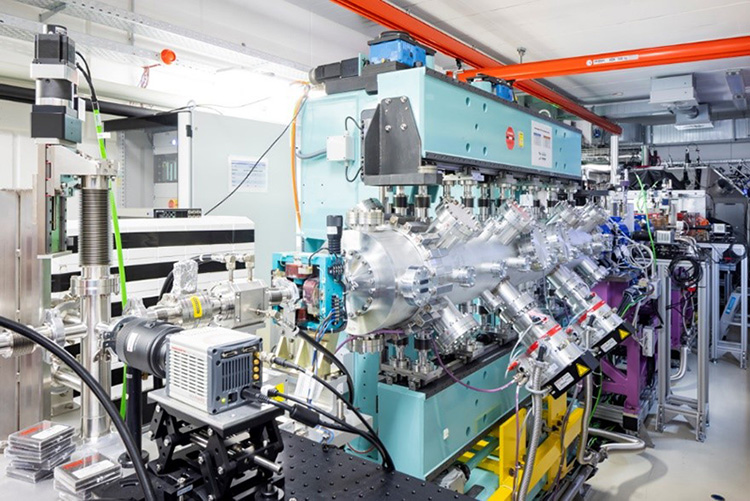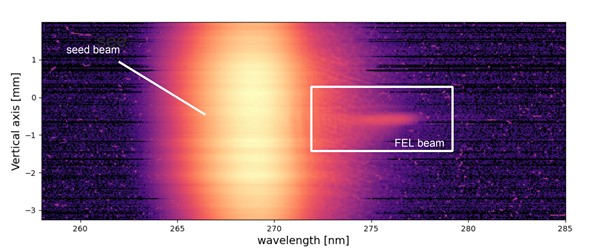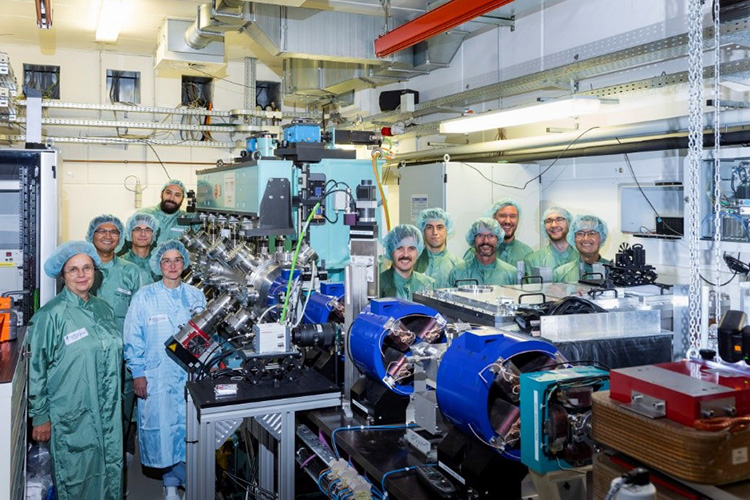Extremely intense light pulses generated by Free-electron lasers (FELs) are versatile tools in research. In the X-ray range, they can be deployed to analyze the detail of atomic structures of a wide variety of materials and to follow fundamental ultrafast processes. Until now, FEL facilities are based on conventional electron accelerators, which make them long and expensive for XFELs.
An international team led by SOLEIL and Helmholtz-Zentrum Dresden-Rossendorf (HZDR, Germany), has now achieved a breakthrough using an alternative solution: they were able to demonstrate seeded FEL lasing in the UV based on a still young technology - laser plasma acceleration. In the future, this might allow to build more compact systems. The results are published in the journal Nature Photonics.
Free-electron lasers such as the European XFEL in Hamburg provide powerful tunable X-ray laser sources. With the help of radio-frequency waves, an accelerator brings electrons close to the speed of light. Then the particles, bundled into bunches, fly through the "undulator" - a magnet arrangement producing a periodical alternating field that forces the electrons onto slalom paths. The electrons, by interaction with radiation, reorganize into many smaller groups (microbunching), and together emit extremely powerful, laser-like light pulses. Those XFEL facilities being several hundred meters or even a few kilometers long, alternative accelerator technologies are under development such laser plasma acceleration, as in HZDR. A high-power laser fires short, ultra-strong light flashes into a plasma, which is an ionized gas of negatively charged electrons and positively charged ions. In the plasma, the light pulse then generates a strong wave of alternating electric fields, similar to the wake of a ship. This wave can rapidly accelerate electrons to higher speed over a very short distance. In principle, this could shrink an accelerator that is now a hundred meters long to a length of much less than one meter.
Successful teamwork
Electrons have long been accelerated using this technique. But only recently, still in an early stage, it has been possible to send such particle bunches from a plasma accelerator through an undulator and then convert them into laser-light flashes. The HZDR and Synchrotron SOLEIL teamed up, and succeeded in generating a seeded FEL laser-light driven by plasma acceleration for the first time, together with LOA and PhLAM collaborators. A plasma accelerator installed in Dresden, driven by the high-power laser DRACO, delivered high quality electron bunches. To generate FEL flashes, HZDR researchers had to produce particle bunches that contain copious amounts of electrons, while keeping as equal energies as possible. In order to prevent the electron bunches from diverging too quickly, a refined trick was used: the so-called plasma lens. The electrons are transported down to the undulator in the COXINEL beamline, developed and brought by SOLEIL, enabling to manipulate the electron beam properties to suit for the FEL application in the ultraviolet (UV) range. COXINEL line had previously been optimized for electron beam-transport, undulator radiation emission, seed overlap with the electron beam over several years using the French plasma accelerator set-up at LOA jointly with PhLAM (Lille). In the employed method called "seeding": an external laser-light pulses are sent into the undulator and interacts with the electrons, enabling to ease the FEL process, and to improve the FEL quality (longitudinal coherence).

Figure 1: The COXINEL free-electron laser (FEL) line from SOLEIL converts the electron pulses generated by the high-power laser DRACO at HZDR into light flashes: undulator (foreground); metallic beam chamber for the DRACO laser (background).
(c) HZDR/Sylvio Dittrich.
A scientific breakthrough
With this setup, the team was finally able to achieve its goal: as hoped, demonstration of the plasma-driven FEL generated ultrashort UV laser flashes. For 15 years, people in the advanced accelerator physics community have been dreaming about realizing a free-electron laser like this. Such a result was always considered one of the most important milestones in this field. Through the HZDR-SOLEIL experiment, a tremendous progress for this field is now achieved.

Figure 2: Successful experiment: Plasma accelerated seeded free electron laser (red-shifted, right) superimposed to the more vertically expanded seed.
But before a plasma-based FEL can be put to practical use, there are still various challenges to overcome. For example, while the setup in Dresden was able to generate UV pulses, research requires high-intensity X-ray flashes - for which the electrons would have to be accelerated to much higher energies. This is already demonstrated in principle with plasma acceleration, but so far the quality of the electron bunches is still too poor and too unstable for an X-ray FEL. There is hope brought by a new generation of high-power lasers. If the endeavor succeeds, laser plasma based free-electron lasers could become available to scientists.

Together with colleagues from Synchrotron SOLEIL, LOA, PhLAM and HZDR, the German-French team succeeded for the first time in generating well-controllable free-electron laser via plasma acceleration.
From left to right: Dr. Marie-Emanuelle Couprie, Dr. Arie Irman, Prof. Ulrich Schramm, Dr. Marie Labat, Dr. Armin Ghaith, Dr. Maxwell LaBerge, Dr. Driss Oumbarek-Espinos, Dr Alexandre Loulergue, Dr. Jurjen Couperus Cabadağ, Patrick Ufer, Dr. Yen-Yu Chang.
(c) HZDR/Sylvio Dittrich.
